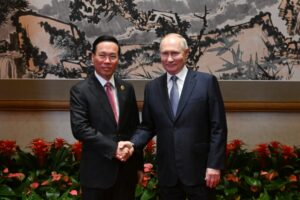Satellite photos obtained by researchers at the James Martin Center for Nonproliferation Studies (CNS) in California show construction is already underway of nuclear missile silos at several desert sites spanning hundreds of square kilometers in China’s Gansu province.
China, which celebrated the 100th anniversary of its ruling Communist Party on Thursday, July 1, amid much pomp and military grandstanding, is building more than 100 new “nuclear” missile silos in a desert area around the western part of the country.
The Washington Post first published the report with satellite images of some 119 construction sites that reflect China’s existing arsenal of state-of-the-art ballistic missile launch facilities.
In response to the NSC reports, the United States said that the large increase in Beijing’s nuclear arsenal was worrisome and called for practical measures to reduce the risks of arms races and potentially destabilizing tensions.
Beijing, on the other hand, has insisted that its military or nuclear arsenal is insignificant compared to that of the United States or Russia and called for bilateral dialogues on strategic security that respect “equality.”
Why does this increase in China’s nuclear missile silos matter?
Since the beginning of the Biden presidency, the United States government has been trying to engage other nuclear powers, including Russia, in an agreement to control and even reduce nuclear nukes and medium-range missiles, thus prioritizing strategic stability among the major nuclear power.
In February 2021, the United States and Russia signed a new START “Strategic Arms Reduction Treaty” treaty.
Within this new rationale for trying to control nuclear weapons, China plays a very important role as the Pentagon estimated last year that China’s nuclear warhead stockpile was around 200, but that it could double in size with the country’s recent effort to develop fuel for a new generation of nuclear reactors.
However, it is worth noting that the United States’ nuclear weapons stockpile consisted of about 3,800 warheads, of which 1,357 were already positioned in silos, submarines, and ready to be loaded by strategic bombers.
In any case, even though China has significantly fewer warheads than the U.S., a unilateral increase in nuclear weapons by China, could destabilize the current arms balance, leading to a new “nuclear race.”
Are intercontinental ballistic missiles still important in the “Nuclear Triad?”
The Nuclear Triad is the name given to the three components of nuclear deterrence generally used by major nuclear powers.
It refers to the ability to launch a strategic nuclear arsenal in three distinct ways:
- ICBMs “intercontinental ballistic missile” (land-based intercontinental ballistic missile) which are the ones being expanded by China
- submarine-launched ballistic missile ICBMs
- strategic bombers that carry nuclear weapons
The goal of having a nuclear capability with three divisions is to significantly reduce the possibility of an enemy destroying all of a nation’s nuclear forces in an initial surprise attack.
The Nuclear Triad, the enemy would not be able to destroy an opponent’s entire nuclear arsenal at once and would be vulnerable to a nuclear counterattack, either by land-based ballistic missiles, via submarines, or via strategic bombers.
This certainty of nuclear counterattack against the initial aggressor leads to the doctrine called MAD “mutual assured destruction”, thus increasing the nuclear deterrence of a nation possessing a Nuclear Triad, as it will not be attacked – nor will it attack – a nuclear nation, as it knows that both will be destroyed.
It was essentially due to the MAD doctrine that we did not have a third world war according to many analysts in international security and geopolitics.
As for the rise of Chinese nuclear silos, it has not worried analysts as much because, according to them, the most advanced nuclear missiles can be launched from submarines and mobile land platforms (essentially trucks) and thus be easily concealed. Nuclear silos, on the other hand, are always prime targets for potential enemies.
So perhaps this increase in Chinese nuclear silos is more for internal propaganda and external force projection than actual effective nuclear strategy.
The construction of these silos may be part of the CCP’s (Chinese Communist Party) internal show of force on its 100th anniversary, and also to show the world that China should be seen to be on an equal footing with the U.S. and Russia in terms of nuclear weapons and to be included in future START treaties between the Russians and Americans.













[…] China said it favors pragmatic cooperation in the Arctic and the construction of a “Polar Silk Road,” in accordance with the draft of the 14th Five-Year Plan (2021-2025) for national economic and social development and long-term objectives up to the year 2035. […]
[…] rising tensions with China in the Indo-Pacific region (the region of oceans between the Middle East and the Sea of Japan […]
[…] the other hand, Russia and China still want to take the hegemony and concentration of power out of the hands of the Americans, […]
[…] Whether with or without NATO, apart from the European community, no one is able to provide lasting security guarantees for the continent. Moreover, this will also increase the bloc’s military projection power, being able to intervene militarily around the planet when they need to and thus taking an even bigger step towards a global Europe and thus growing as a third world potential together with the US and China. […]